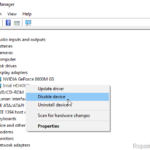The blue screen error “IRQL_NOT_LESS_OR_EQUAL (dxgmms1.sys) or (dxgmms2.sys), points to problems with DirectX. DirectX is a set of components in Windows that allows software, primarily and especially games, to work directly with your video and audio hardware.
The BSOD error “IRQL_NOT_LESS_OR_EQUAL (dxgmms2.sys) or (dxgmms1.sys) in Windows 10, commonly happens when the user is playing games, or when viewing video either by using a Media Player (e.g. the ‘VLC Media Player’) or when viewing a video in full screen mode by using the Chrome or the Firefox Web browser. In all cases, the BSOD problem occurs only with NVIDIA graphics adapters (and not with AMD), and so far, there is not exist a permanent solution from NVIDIA (or Microsoft) to fix the problem.
In this tutorial you ‘ll find several methods to to resolve the IRQL NOT LESS OR EQUAL (dxgmms1.sys / dxgmms2.sys) blue screen error in Windows 10 OS.
How to FIX: DRIVER IRQL_NOT_LESS_OR_EQUAL (dxgmms1.sys) or (dxgmms2.sys) BSOD.
Method 1. Install a more stable driver for your NVIDIA adapter.
1. Navigate to Control Panel > Programs and Features and uninstall all the NVIDIA software and drivers from your system.
2. When the uninstall operation is completed restart your computer.
3. After restart navigate to NVIDIA advanced driver search page and search for a driver for your display adapter. *
* Note: If you own a laptop, then you may need to find the VGA drivers from manufacturer’s support site.
4. From the results, download the “GeForce Game Ready Driver WHQL – 385.69“.
5. Install the driver you downloaded and then restart your computer.

Method 2. Disable the Secondary Display Adapter.
If you own a laptop with a discrete GPU, or a motherboard with an onboard Intel display adapter (VGA), then proceed and display the 2nd display adapter (Intel) from the device manager.
1. Press Windows ![]() + R keys to open the run command box.
+ R keys to open the run command box.
2. Type: devmgmt.msc & click OK to open ‘Device Manager’.
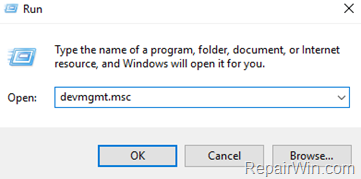
3. In Device Manager expand the Display Adapters.
4. Right click on the Intel display adapter and select Disable device.
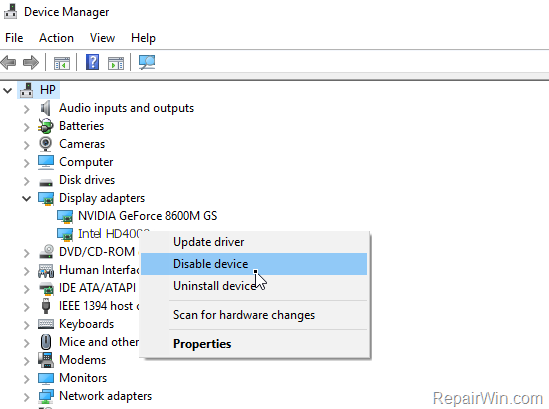
Method 3. Display Hardware Acceleration in the Web browser.
If your computer crashes with BoSD “IRQL_NOT_LESS_OR_EQUAL (dxgmms2.sys) or (dxgmms1.sys)” when working (or viewing videos) on your web browser, then proceed and disable the hardware acceleration.
To disable the Hardware Acceleration in Google Chrome:
1. From Chrome menu ![]() choose Settings.
choose Settings.

2. Scroll the ‘Settings’ page down and click Advanced (at the end of the page).
3. Set the ‘Use hardware acceleration when available‘ to OFF.
4. Close and re-launch Chrome.
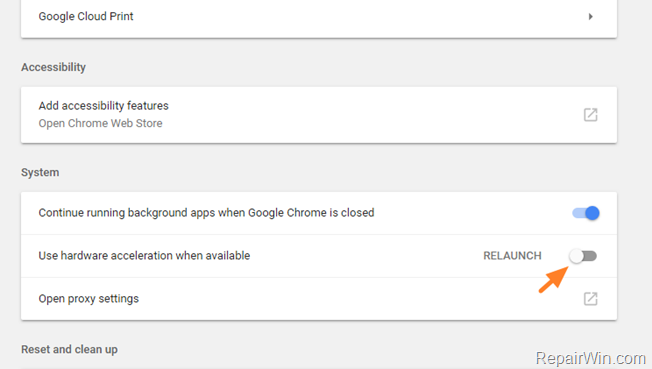
To disable the Hardware Acceleration in Mozilla Firefox:
1. From Firefox menu ![]() click Options.
click Options.

2. Uncheck the ‘Use recommended performance settings’ option and then uncheck the ‘Use hardware acceleration when available‘ option.

4. Close and re-launch Firefox.
Method 4. Modify Virtual Memory Settings (Paging File).
In some cases the “IRQL_NOT_LESS_OR_EQUAL” problem may caused from invalid settings in paging file (Virtual Memory). To fix this issue:
1. Press Windows ![]() + R keys to open the run command box.
+ R keys to open the run command box.
2. Type sysdm.cpl & click OK.
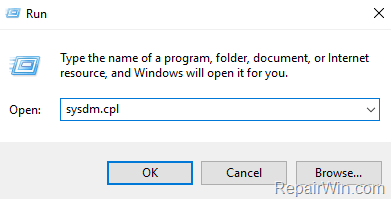
3. At Advanced tab select Performance Settings.
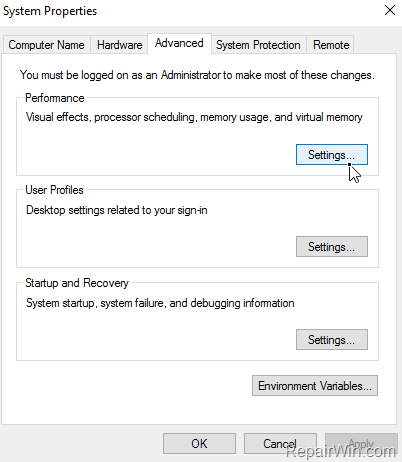
4. At Performance Options, select the Advanced tab and then click Change.
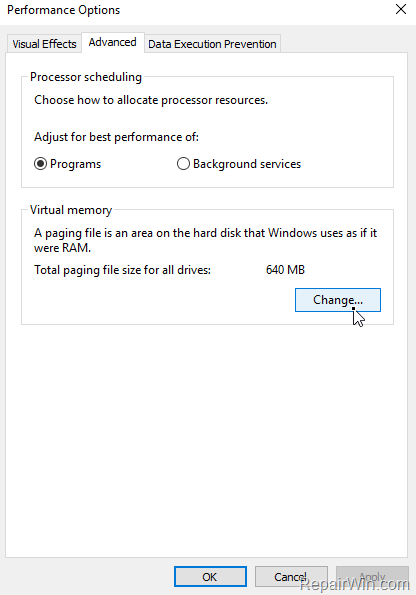
5. Uncheck the Automatically manage paging file size for all drives checkbox.
6. Select the Custom Size option.
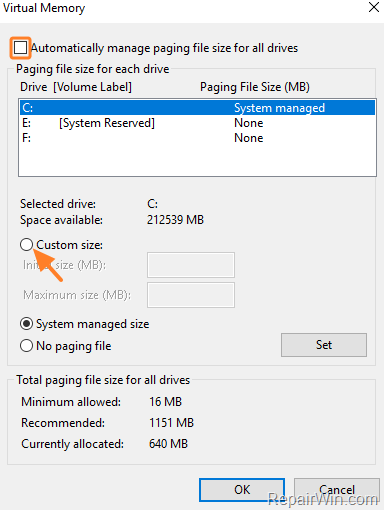
7. Now type into both the İnitial size(MB) and Maximum size(MB) box a value that is one and half times (1,5) the amount of RAM installed on your System.*
* e.g. If the installed RAM memory is 8GB (8192MB) then type: 12288 (1,5 x 8192 = 12288).

8. When done click Set and then click OK to apply changes and Restart your computer.
Method 5. Scan and Repair Windows System Files.
1. Open an elevated command prompt. (with administrative privileges).
2. In the command prompt window, type sfc /scannow and press Enter:

3. When the SFC process is completed, type the following command and hit Enter:
- DISM.exe /Online /Cleanup-image /Restorehealth

Method 6. System Restore.
If the “IRQL_NOT_LESS_OR_EQUAL (dxgmms1.sys)” occurred after a Windows Update, try to restore your computer to a previous working state.
1. Press Windows ![]() + R keys to open the run command box.
+ R keys to open the run command box.
2. Type rstrui & click OK.
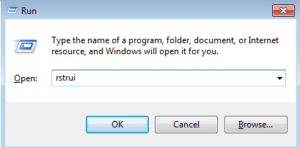
3. Click Next at the first screen.
4. Choose an earlier working state (Date/Time) and click Next to start the restore process.
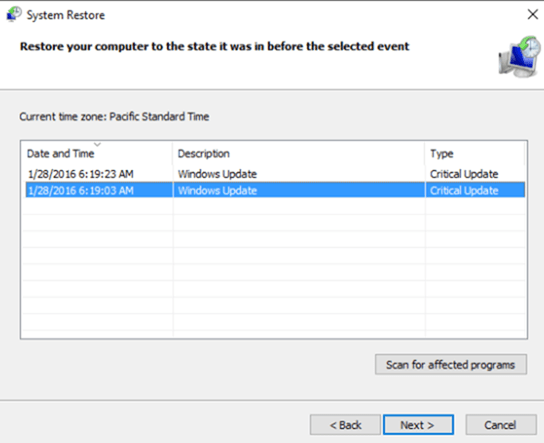
Method 7. Analyze Minidump (BSOD) log file.
When Windows crashes with a blue screen, stores the details of the BSoD screen to small file(s), which called “MiniDump“. The analysis of the Minidump file(s) can help you to troubleshoot and resolve the blue screen problem. To accomplish this task follow the instructions in this article: How to Analyze MiniDump Files with BlueScreenView.
That’s all! Did it work for you?
Please leave a comment in the comment section below or even better: like and share this blog post in the social networks to help spread the word about this solution.


